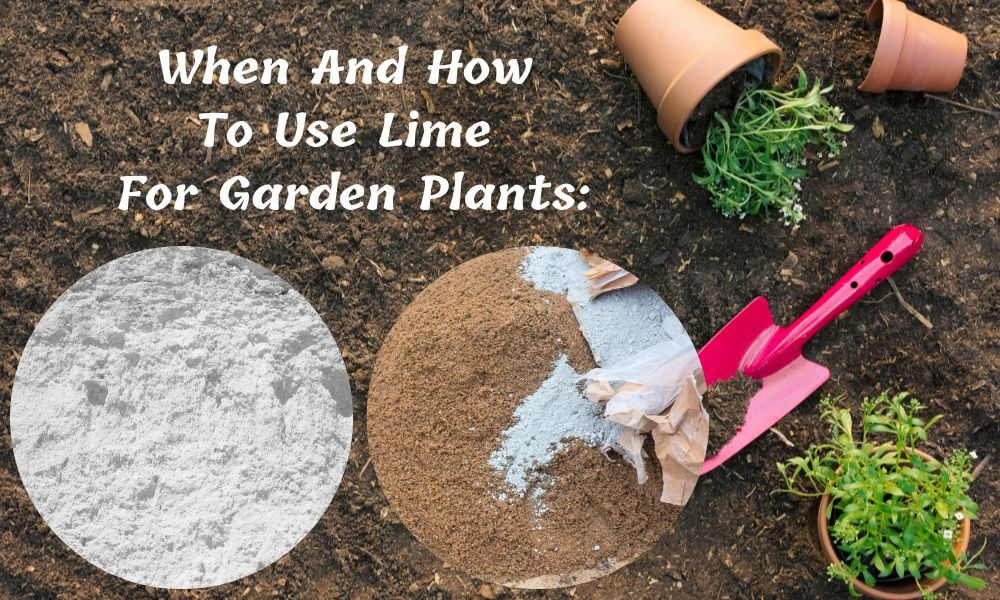Lime is often associated with paan (betel leaf) and household whitewashing, but it also plays a significant role in gardening. Garden plants require essential nutrients like calcium and magnesium, which lime can provide. Lime for garden plants not only corrects nutrient deficiencies but also helps absorb vital elements like nitrogen and zinc, ultimately leading to robust crop yields. Additionally, applying lime in home gardens helps repel pests like aphids and flea beetles. Garden lime is commonly used on plants such as tomatoes and eggplants.
Learn when and how to use lime for garden plants with this informative article. Be sure to read to the end to fully understand all the important details related to the lime used in the garden.
Types Of Garden Lime

Two types of lime are commonly used in vegetable gardens:
- Dolomite Lime
- Hydrated Lime
Dolomite Lime For Garden Plants:
In gardening, dolomite lime is the preferred choice. It has a higher concentration of calcium (20%) and magnesium (10%) and is also known as calcium magnesium carbonate (CaMg(CO3)2) or garden lime. Dolomite lime comes in a powdered form and does not dissolve in water, so it is usually mixed with soil.
Hydrated Lime For Garden Plants:
Hydrated lime, also known as slaked lime or calcium hydroxide (Ca(OH)2), is created by adding water to solid limestone. This type of lime is readily available in stores and is used to increase the calcium content in soil. It is commonly used in gardens and vegetable patches.
(Read More: Vegetable Seeds Sowing or Planting Chart / Calendar…)
Garden Lime Benefits
You may wonder why lime powder is used on vegetable plants and what benefits it offers. Let’s explore the advantages of applying lime to vegetable plants:
- Lime application is common for crops like tomatoes, brinjal, and chilli because they require calcium and magnesium for fruit and seed production.
- Lime enhances the absorption of essential nutrients like nitrogen, phosphorus, and zinc by vegetable plants.
- Lime usage in the garden helps protect plants from pests such as aphids and flea beetles.
- Lime raises the pH level of acidic soil (pH less than 5), making it less acidic. Therefore, it is beneficial for vegetables grown in slightly alkaline soil.
When To Use Lime for Garden Plants
Understanding the ideal timing for applying lime to vegetable plants is crucial. Here’s when you should consider using lime in your garden:
- During soil preparation for planting, you can mix lime powder into the soil for at least 3 weeks before transplanting seedlings. This allows the lime to mix well with the soil.
- After transplanting seedlings into the garden and ensuring they are well-established, you can apply lime to the soil or use lime water.
- Lime is usually applied to vegetable plants when they begin to flower and when the fruits are partially developed.
How To Apply or Use Lime For Garden Plants

You can apply lime powder to vegetable plants in two ways:
- Mix lime powder directly into the soil.
- Dilute hydrated lime in water and apply.
Here’s how to apply lime water and lime powder to potted vegetable plants:
- When using dolomite lime, you can mix a tablespoon of lime powder with the soil while preparing the soil for planting. After adding the powder, ensure thorough mixing and follow it with good watering to help it incorporate into the soil.
- If you are using hydrated lime, start by preparing a bucket or watering can.
- Determine the amount of lime water you need based on the number of plants. For regular use, mix approximately one teaspoon (5 grams) of hydrated lime in 1 litre of water. For larger areas, use Three tablespoons (15 grams) of hydrated lime in 3 to 4 litres of water.
- Once the lime is fully dissolved in water, you can apply it to the soil around the vegetable plants. Alternatively, you can use the lime water for foliar spray by applying it to the plant’s leaves.
(Read More: Flower Seed Sowing / Planting Chart – Calendar…)
Using Lime When Preparing Soil
When preparing soil for planting, add lime to the soil at least 20-25 days before planting seedlings. To do this, you can mix approximately 1 tablespoon (15 grams) of dolomite or hydrated lime with about 5-6 kilograms of soil per square meter. Alternatively, you can use a soil pH meter to determine the soil’s pH and adjust the lime application accordingly. Be sure to water the soil thoroughly after incorporating the lime powder into it. After about a month, the lime-treated soil will be ready to use for planting your vegetables or transplants.
Using Lime in Potted Vegetable Plants

For potted vegetable plants in your home garden, a small spoonful of lime (about 5 grams) is usually sufficient for a single plant.
By following these guidelines, you can effectively utilize the benefits of lime to promote a thriving and abundant vegetable garden.
Which Garden Plants Need Lime
Many garden plants benefit from lime, including:
- Vegetables: Legumes like Peas and Broad Beans, Tomato, Brinjal, Chili, Onions, Garlic, Beetroot, Parsnips, Asparagus, Spinach, Cabbages, Lettuce, and other Leafy vegetables.
- Fruit trees, as Apple
- Roses
Note: Many acid-loving garden plants do not like lime, including potatoes, sweet potatoes, Rhododendrons, Azaleas, Berries and grapes
